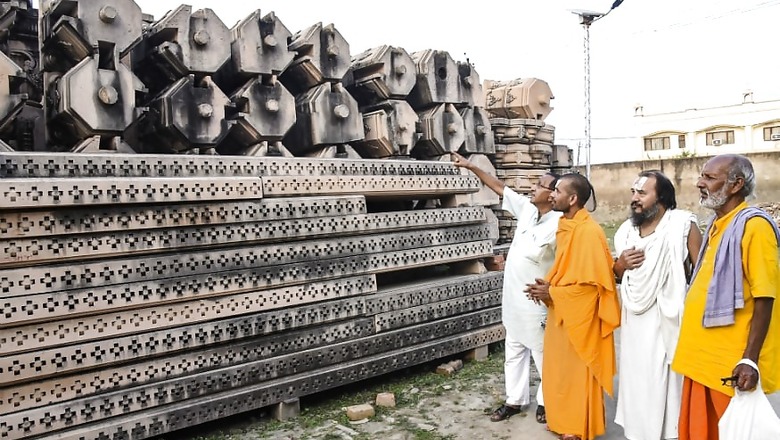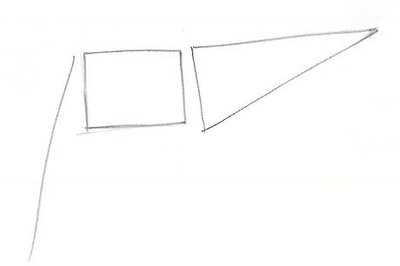
views
An ascetic from the temple town of Ayodhya, an engineer who later became a dedicated Rashtriya Swayamsewak Sangh (RSS) volunteer and a politician born in present-day Pakistan who went on to become India’s deputy prime minister – these are the three men who perhaps played the most crucial role in turning what began as a local land dispute under British rule into the biggest religiopolitical flashpoint in independent India.
With the Supreme Court on Wednesday ordering an end to hearings in the long-running Ram Janmabhoomi-Babri Masjid title suit and the verdict expected next month, the actions of the triumvirate that shaped the country’s collective conversation have come into sharp focus.
Paramhans Ramchandra Das
The first of the three was Paramhans Ramchandra Das. Born in 1913 as Chandreshwar Tiwari in a Bihar village, he moved to Ayodhya a few years later and became an ascetic, now called Paramhans Ramchandra Das. According to historical records in public domain and the volumes of writings on the subject, Das was the city president of the Hindu Mahasabha for Faizabad at the time when the idol of Ramlalla was placed inside the central dome of the Babri Masjid in Ayodhya on the intervening night of December 22 and 23 in 1949, two years after Independence.
Though the first FIR filed at 9am on December 23, just hours after the incident, didn’t name Ramchandra Das, it had the names of a few of his acquaintances – Abhiram Das, Ramsakal Das, Sudarshan Das – and around 50 other unidentified people. Abhiram too was associated with the Hindu Mahasabha.
Paramhans Ramchandra Das was never formally accused in the case, but years later he claimed to have executed the event of December 1949 that remains one of the biggest turning points in the dispute. It was only after the idol was placed inside that Babri Masjid was officially declared a “disputed site”. Its main gate was closed and Muslims were barred from offering namaz at the place, even while the Hindus got the right to a darshan (viewing) from a side gate.
It was 1991, when Ramchandra Das told the New York Times: “I am the very man who put the idol inside the masjid.” However, in the years that followed, he largely maintained silence on his role. Even if their remains ambiguity over his actions, in his lifetime he became the most prized saint in Vishva Hindu Parishad (VHP) and Bharatiya Janata Party (BJP)’s scheme of things as the two stoked the temple movement.
In 1984, as the VHP attempted to spearhead the Ram Mandir campaign by organising its first dharma sansad (religious parliament), Das was a key participant. It was under the supervision of the saffron group that the Ram Janmabhoomi Nyas was later formed and Das went on to become its president. He held this post till his death.
During the heyday of the temple movement he remained one of the most crucial voices from among the saints and seers in Ayodhya, extending support to every call of agitation made by the VHP. In February 1986, as the locks of Babri Masjid were opened by court order and legal suits were transferred from Faizabad to the Lucknow bench of the Allahabad high court, Das too filed a suit in the HC, but it was withdrawn later, paving the way for another suit filed by Ram Lalla Virajman through the deity’s “sakha” (friend) Deoki Nandan Agarwal, a retired high court judge and vice-president of the VHP.
Ashok Singhal
Born in 1926 in Uttar Pradesh’s Agra town, Singhal came from an influential family. His father was a government official while his younger brother BP Singhal went on to become UP’s director general of police and a BJP Rajya Sabha member. A brilliant student, Ashok Singhal studied metallurgical engineering from Banaras Hindu University, now IIT (BHU). There he had his first introduction with right-wing ideology and soon decided to commit himself to the cause of the Rashtriya Swayamsevak Sangh (RSS).
He became a full-time pracharak (proponent) of the RSS in 1942, the year when India was witnessing the Quit India Movement under the leadership of Mahatma Gandhi against the British Raj. As a Sangh volunteer he worked in various capacities across parts of UP and also became the praant pracharak (provincial proponent) for the Delhi unit of the Sangh.
In 1981, he was moved to the position of national joint general secretary with the VHP, one of the most important affiliates of the RSS. Three years later, Singhal’s tryst with destiny, as far as the Ram temple movement is concerned, began. The VHP organised its first dharma sansad to discuss the Ram Janmabhoomi-Babri Masjid dispute. Saints and seers were mobilsed and roped into the Ram temple cause. Singhal played a pivotal role in making the event a grand success. Soon after, he was promoted as national general secretary of the outfit.
While occupying this position and subsequently as the working president of the VHP, Singhal played the most significant part in shaping the movement, chalking strategies and ensuring a rise in the popularity of the RSS’s Hindutva ideology. He became a valuable link between the saints-seers and community leaders on one hand and politicians represented by the BJP on the other.
From 1984 onwards, right through the stormy days of shilanyas (laying of foundation stone), kar seva (voluntary religious service) and finally the demolition of the mosque on December 6, 1992, Singhal remained at the helm of affairs. As Babri Masjid was torn down by right-wing activists and FIRs were filed in connection with the crime committed, Singhal was one of the key persons named as accused.
The FIR filed as ‘crime no. 198’ on the evening of the incident accused Singhal along with Lal Krishna Advani, Murli Manohar Joshi, Vishnu Hari Dalmia, Uma Bharti, Giriraj Kishore, Vinay Katiyar and Sadhvi Ritambhara of making provocative speeches, thereby encouraging the kar sevaks to pull down the mosque.
Following the demolition, as the BJP reaped the benefits through the rise of Hindutva politics and eventually tasted power at the Centre – first through short- lived governments and then in 1999 when it, along with allies, got back to holding the reins of the government and completed a full five years in office with Atal Bihari Vajpayee as the prime minister, Singhal probably felt cheated. Observers say he was of the opinion that the Vajpayee government was not doing much for the Ram Mandir cause.
The mascot of the temple movement was compelled to sit on fast unto death, protesting against what he called the callous approach of the government towards the Ram temple campaign.
From then till his death in 2015, Singhal continued to struggle for the cause he so deeply believed in. He wanted to see the court battle reach its conclusion. That did not happen.
Lal Krishna Advani
The third of this troika and the only one alive and still active in public life is Lal Krishna Advani: the politician most influential in crafting the course of the Ram Janmabhoomi agitation. Unlike former prime minister Atal Bihari Vajpayee, his closest confidant in politics, Advani chose to become the hardline face of the temple movement. While Vajpayee was more comfortable with often being referred to as wearing a mukhauta (mask), Advani led from the front.
Born in 1927 in the Sindh province of present-day Pakistan, Advani too got associated with the RSS very early in his life, becoming a pracharak in 1941. After Partition, he was sent by the Sangh to Rajasthan. His role changed in the early 1950s as the Bharatiya Jana Sangh was formed as a political offshoot to promote the RSS ideology. Advani stepped into the political arena.
In 1957, he was moved to Delhi to look after the party’s affairs. He steadily climbed up the ladder, becoming a member of the Rajya Sabha in 1970. Following the Emergency in 1977, the Jana Sangh merged into the Janata Party and later formed the first non-Congress government at the Centre. Advani was made the information and broadcasting minister.
In 1980, the Bharatiya Janata Party was formed. Vajpayee became its first president. The party’s guarded approach towards the Ram Janmabhoomi issue didn’t pay any significant dividend in the 1984 general elections that were held amid nationwide outrage after Prime Minister Indira Gandhi’s assassination.
Following this, the BJP shifted to politics of staunch Hindutva and no-holds-barred commitment to the issue of Ram Mandir. It also triggered a transformation in Advani’s political profile. He was brought in as the president of the BJP. From then, he became the most aggressive voice and campaigner from the BJP for the temple campaign. Though the likes of Vajpayee and Joshi did play their part, Advani clearly was leading the pack.
Under Advani, the BJP adopted a combative posture on the issue and vigorously participated in agitations and campaigns over the next few years. The gains came in the 1989 general elections when the party with two MPs saw its tally shoot up to 89.
In 1990, as the temple movement was at its peak, Advani took on the most controversial and virulent campaign of his political career – the Ram Rath Yatra, from Somnath in Gujarat to Ayodhya in Uttar Pradesh. Present prime minister Narendra Modi was the architect of Advani’s yatra plans. The procession though never reached Ayodhya, as it was stopped and Advani was arrested by the-then Bihar chief minister Lalu Prasad Yadav’s administration.
But the purpose was fulfilled. Advani was established as the hardline face of the Ram temple cause. The movement was riding waves of popularity. There was no stopping it now. Two years later, the Babri Masjid was brought down by kar sevaks.
Advani was named as a key accused for delivering inflammatory speeches to the activists. However, with the mosque gone, the immediate issue of “provocation” was gone as well. Following this, the BJP emerged as a political force across the country and Advani held several senior posts at the Centre, going on to become the deputy prime minister in the BJP-led National Democratic Alliance (NDA) government in 1994.
In 2004, as the NDA lost the electoral battle, paving the way for the Congress-headed United Progressive Alliance (UPA) government, Advani’s confrontation with legal trials in the demolition-related cases began. In 2009, the BJP once again failed to regain power at the Centre, despite the party contesting the elections with Advani as the prime ministerial candidate.
Following the defeat, Advani found himself slowly sidelined in the party with new leadership emerging under Narendra Modi. Today, though he is a member of the Lok Sabha, he is part of the nondescript “margdarshak mandal” (group of mentors) of the BJP.
But at 92 years of age, when most of his associates have passed away, Advani is the only one who can hope to witness the resolution of this vexatious dispute that has changed India forever.
(As the Ayodhya land dispute case draws to a close, a News18 series traces the journey of one of the most protracted legal battles in the history of independent India.)
















Comments
0 comment